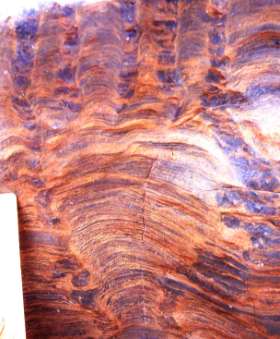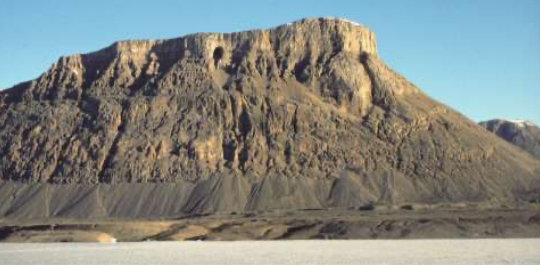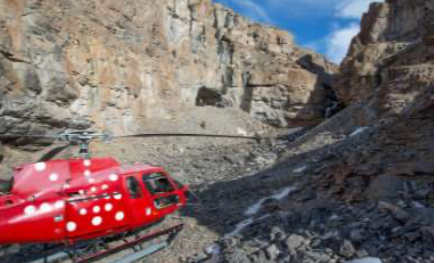Winter Programme Abstracts 2023-2024
2023The presentations will usually be available through Zoom. Please contact the Secretary for access details.
Wednesday 21st September
Stromatolites: Making Mountains out of Microbes (WGCG)
Professor Ian Fairchild (University of Birmingham)

Stromatolite palmistry? Course of future evolution foretold?
For most of Earth history the only macroscopic evidences of life are the intricately layered rocks called stromatolites. Like trace fossils, they record an interaction between organisms and sedimentary processes. The key players are the cyanobacteria, formerly known as blue-green algae, which played a vital role in oxygenating the Earth by their photosynthesis. Build-up of sediments and precipitates, over time, under the sticky surface mats created by communities of such organisms, can make limestone and dolomite masses up to hundreds of metres thick.
Stromatolites reveal many fascinating stories of past environments, and examples from several continents are discussed.
The YouTube link for this talk is: https://youtu.be/5FjXmQpw7xk
Wednesday 11th October
Excavating Plesiosaurs
Richard Forrest (Peterborough Geological and Palaeontological Group)
Marine reptiles of the Jurassic, found in the UK, represent the largest collection of these amazing and charismatic animals from anywhere in the world. Museum collections contain many hundreds of such specimens, and many more are in in private collections, both in the UK, and other countries. Most specimens in such collections are relatively poorly documented. This limits the possibilities for unravelling the stories of the life and death of these animals from such scant evidence.
New specimens turn up regularly, but mainly from sea cliffs, or quarries, where there is a narrow window of opportunity to collect. Many are lost to quarrying operations or erosion, or are collected piece-meal and distributed between several different collections.
The Peterborough Geological and Palaeontological Group has developed a close working relationship with managers and operators, and by doing so has gained access to working quarries. When significant finds are made, it has been possible to carry out systematic excavation of several large marine reptiles with the full cooperation of the quarry management. This careful approach to uncovering and collecting such specimens, has recorded a wealth of data which can be used for scientific studies of taxonomy, taphonomy, sedimentology and other fields of research.
This talk is about three such finds made by members of the group.
Thursday 16th November
The Geology and Birds of Flamborough Head (WGCG)
Paul Hildreth (YGS)
Flamborough Head is Englands' most northerly outcrop of the Late Cretaceous Chalk Group, and is home to the highest chalk sea cliffs, and the only mainland gannet colony in the UK. In recognition of these latter claims, the RSPB has established the very popular, and successful, Bempton Cliffs Reserve which sees around half a million seabirds gather here, between March and October, to raise a family on towering cliffs overlooking the North Sea. Perhaps the most popular attraction is the puffin colony, though each visitor will have his or her own favourite.
The headland, founded on solid chalk, has a blanket of Quaternary deposits, mainly till and stratified gravels. In places such as Danes Dyke, these deposits fill deep ravines cut into the chalk bedrock, and provide a completely different habitat from the cliffs at Bempton. A walk from the car park to the beach, in early May, will take you through woodland where the sometimes harsh calls of seabirds give way to the more melodious sounds of the blackcap, wren and robin and the ‘tapping’ of woodpeckers.
The ornithologist notes that the northern side of Flamborough Head hosts most, if not all, of the breeding sites for sea birds such as gannet, guillemot, razorbill and puffin. The geologist notes that the Chalk of the northern side of the headland is different from that on the southern side, and that there is a significant variation in the influence of the Quaternary “blanket”. So this talk combines these observations, and looks for possible geological explanations to variations in bird distribution. In doing so I throw in some questions based on observation: do guillemots use clinometers; can seabirds recognise deformed rock layers; and are gannets and auks fellow members of the Flint Appreciation Society?
The preparation of this talk was helped by the staff at RSPB Bempton Cliffs; in particular Sarah Aitken, with whom I collaborated for a number of years, and for whom the YGS produced an information leaflet ‘The Geology of Bempton Cliffs’ for visitors to the reserve. Peter and Sylvia Nettleship, of Buckton, provided historical data, and a ‘seabird fact sheet’; and almost all of the stunning bird portraits are supplied by an old-school friend, Tony Malt from Malton, who came on a Yorkshire Geology Month boat trip from North Landing in 2016.
Wednesday 10th January 2024
Celebrating the Origins of Animal Life: Building a UNESCO Global Geopark in Charnwood Forest, UK
Dr Jack Matthews (Geoheritage Officer National Forest Company)
Charnwood Forest in Leicestershire is host to some of the oldest animal fossils in the world; many of which have been key to our understanding of the rise of animals during the Ediacaran period, around 570 million years ago. In addition to its internationally significant palaeontology, the area is also home to a number of working and historic quarries, whose lithologies have shaped the built environment of the United Kingdom for more than 2000 years. This presentation outlined the internationally significant geodiversity of Charnwood Forest - including the outstanding ancient fossils - and the ways it has shaped the landscape, communities, and people of Britain’s ‘unexpected upland’. The talk also outlined the work being undertaken towards applying for UNESCO Global Geopark status for the area.
Thursday 18th January
Volcanoes in the spotlight; Exciting examples from La Palma, Stromboli and the ancient rock record (WGCG)
Dougal Jerram
Recent advances in the capture of 3D geological data has re-invigorated the way in which we study volcanoes and their deposits. The recent eruption on La Palma, and ongoing active volcanoes such as Stromboli, act as modern-day laboratories, to observe and record, while the ancient rock record is the legacy of such eruptions. Here we explore some exciting footage, and details of the 2021 La Palma eruption, which Dougal visited in person. We hear about techniques developed for mapping volcanoes in 3D on Stromboli, and will look forward to the role of digital geology in the ancient rock record.
The YouTube link for this talk is: https://www.youtube.com/watch?v=xb__01XJ9sY
Wednesday 14th February
Metal capture by Tufa: a natural process to engineering solutions?
Dr Susan Cumberland (University of Leicester)

The leaching of heavy metals from legacy post-industrial slag, and other anthropogenic waste sites, is detrimental for human health and the wider environment. Tufa is a surface mineralised material that forms naturally when calcium-rich groundwater is exchanged with atmospheric CO2 at mid- to hyper-alkaline pH, resulting in a precipitation of calcite (CaCO3). Anthropogenic tufa may occur at old industrial sites (e.g. mining, steel works, paper mills) across northern England and Scotland. At the Howden Burn, near Consett in NE England, tufa forms in the stream as it emerges from the slag from the old steel works. Analysis of the streamwater, downstream of the tufa, shows metal concentrations are lower compared to those upstream. Examination of the solid tufa shows the presence of lead, arsenic, vanadium and zinc up to several 100 ppm. Cross-sectional element maps, at high resolution, of the tufa, using synchrotron µ-X-ray fluorescence (μXRF), reveal interesting pattens of metal distribution within the tufa laminations. This leads to the hypothesis that the metals precipitate together with the tufa during formation. Understanding, and exploitation of, artificial tufa for metal capture could have potential as a CO2 positive solution for sustainable in-stream remediation. This potential led to conducting experiments in engineering tufa to clean up metal leaching, as part of a doctoral project, and some preliminary results are shown.
Thursday 15th February
The caves of North Greenland - physical records of cryptic geological intervals (WGCG)
Professor Paul Smith (Oxford University Museum of Natural History)
Carbonate rocks of Neoproterozoic to Silurian age are abundantly distributed around the coasts of North and North-East Greenland. Large cave entrances are distributed across the whole of North Greenland, an ice-free area larger than England, from 80–82.5°N, and they constitute the northernmost documented karst caves globally. Data relating to the caves in this remote region have been collected on field expeditions over a 40-year period, and they provide information about palaeoclimates in otherwise poorly-documented geological intervals. These geologically young caves are mainly phreatic (sub-water table) conduits, and they are consistently located a few 100 m beneath the distinctive plateau that characterises the topography of the northern coast. Their identical context suggests that they developed in a single phase of cave formation; and the timing of cave development is constrained by the mid- to late-Miocene (15–5Ma) uplift of the plateau surface, and the onset of fjord-forming glaciation, in the latest Pliocene – earliest Pleistocene (c. 2.7–2.5 Ma). The caves of North and North-East Greenland offer a glimpse of large-scale phreatic drainage-systems that developed below an uplifted coastal peneplain during Neogene time. They preserve an important part of the geological history of North and North-East Greenland, that is otherwise absent from the physical geological record.

Wednesday 13th March
Lincoln Cathedral - Back to the Future
Dr Michael Ashton
Lincoln, arguably Englands' finest Gothic Cathedral, is unique amongst English cathedrals in being built on the stone from which it is constructed: Lincoln Stone. For over 150 years its on-going restoration programme has been sourced from the Cathedral’s own quarry in the northern outskirts of the city. However, in 2021 the quarry was decommissioned, triggering two actions: the acceleration of a review of the Cathedral’s external fabric, and the search for an alternative source of stone, to supplement existing stocks, and ultimately provide a sustainable supply for decades to come.
The talk identifies some of the Cathedrals' main characteristics, prior to describing the stratigraphy and sedimentology of Lincoln Stone, in the context of the Lincolnshire Limestone Formation; drawing particular attention to why it differs from the more famous building stones of the Lincolnshire Limestone: Ancaster; Barnack; Clipsham; Ketton and Weldon. From this framework, the actual fabric of the Cathedral will be explored, with both surprises and enigmas illustrated – these broaden the understanding of the ‘fabric team’ of masons, conservators, archaeologists, and geologists alike, and colour the 900-year history of the monument. Finally, the current work, to find a new stone source for the Cathedral, will be discussed in terms of the geological and societal challenges. Ultimately, the prize is matching the honey-yellow majesty of Lincoln Stone that has for centuries crowned the historic city of Lincoln.
Thursday 21st March
The early evolution of animal life and the generation of form
Dr Frankie Dunn (Oxford University Museum of Natural History)
The rise of the animals was a profound transition in the History of Life. For the first time, organisms were able to engineer the environment around them; altering geochemical cycles; building complex ecosystems, and diversifying into myriad forms. However, the rise of the animals is also one of the most controversial episodes in Earth History. Most major animal-groups appear in the fossil record during a major evolutionary radiation event between ~550 and 520 million years ago, known as the Cambrian Explosion, when the blueprints for the animal phyla (arthropods, vertebrates, cnidarians) were laid down, and, remarkably, have remained more-or-less unchanged in the half a billion years since. My research is focused on the Period of time just before the Cambrian Explosion – the Ediacaran Period, and the Ediacaran-Cambrian transition. While fossil representatives of the living animal phyla diversify in the Cambrian Period, the timing, and nature of their earliest antecedents, remains controversial. Fossil assemblages from the late Ediacaran Period (570 – 540 Ma) preserve the remains of fossil organisms with long-extinct bodyplans, historically excluded from analyses of the early evolution of animals because of extreme uncertainty regarding their phylogenetic placement. My novel approach to the study of these organisms has been to investigate their growth and development across whole populations of taxa with non-analogue frond-like bodyplans. My work has revealed new developmental characters that can be used to rigorously constrain the phylogenetic position of these fossils. In this talk, I introduce my work on the fossils of the Ediacaran Period, and set out the case for an animal affinity, but also discuss new fossil finds, which suggest that the oldest yet known crown-group members of animal phyla lived and died, hidden amongst the fronds.
Monday 25th March 2024
CriticalTechnology Metals and Mining in the 21st Century
Dr Philip Bird (Senior Science Officer at DEScycle & Leicester University)
Life in the 21st century is intrinsically linked to the use of metals. Common base metals, such as copper, weave through the structure of our homes as electrical wires and pipes; we carry gold and other precious metals with us as jewellery; and exotic technology metals lace the circuit boards of our phones, computers, and televisions; we live our lives surrounded by metal. Modern industry and technology now use a greater diversity of metals than at any other point in history, with over 60 metals being ‘critical’ to everyday life. Of these, the technology metals are perhaps the most urgent, possessing characteristics required for technologies, including those vital to the low-carbon energy transition.
The security and sustainability of the supply of metals has become a key issue for governments, businesses and communities across the world. While the supply of base and precious metals is considered secure, the extraction of these commodities is energy- and water- intensive, and produces significant rock waste and CO2 emissions. The supply of the vital technology metals is less certain. Many of these elements are produced only as by-products during the refining processes associated with the major base, and precious, metals, making their production dependent on demand for the related commodity. Even those with more robust supply chains, such as lithium and the rare earth elements (essential for electric vehicle and green energy technologies) are often geographically restricted in their distribution, making supply dependent on geopolitical conditions.
The talk explores concepts around mining, and resource extraction, in the 21st century, and the challenges of meeting long-term demand for metals in a sustainable way. With metal demand projected to peak in the 2040s, as the bulk of low emission infrastructure is constructed, we have a limited window to ensure the production of metal is done responsibly, and to the benefit of all involved.